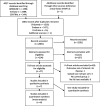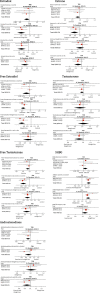Effect of exercise and/or reduced calorie dietary interventions on breast cancer-related endogenous sex hormones in healthy postmenopausal women
- PMID: 30071893
- PMCID: PMC6090977
- DOI: 10.1186/s13058-018-1009-8
Effect of exercise and/or reduced calorie dietary interventions on breast cancer-related endogenous sex hormones in healthy postmenopausal women
Abstract
Background: Physical inactivity and being overweight are modifiable lifestyle risk factors that consistently have been associated with a higher risk of postmenopausal breast cancer in observational studies. One biologic hypothesis underlying this relationship may be via endogenous sex hormone levels. It is unclear if changes in dietary intake, physical activity, or both, are most effective in changing these hormone levels.
Objective: This systematic review and meta-analysis examines the effect of reduced caloric dietary intake and/or increased exercise levels on breast cancer-related endogenous sex hormones.
Methods: We conducted a systematic literature search in MEDLINE, Embase, and Cochrane's Central Register of Controlled Trials (CENTRAL) up to March 2017. Main outcome measures were breast cancer-related endogenous sex hormones. Randomized controlled trials (RCTs) reporting effects of reduced caloric intake and/or exercise interventions on endogenous sex hormones in healthy, physically inactive postmenopausal women were included. Studies including women using hormone therapy were excluded. The methodological quality of each study was assessed by the Cochrane's risk of bias tool.
Results: From the 2599 articles retrieved, seven articles from six RCTs were included in this meta-analysis. These trials investigated 1588 healthy postmenopausal women with a mean age ranging from 58 to 61 years. A combined intervention of reduced caloric intake and exercise, with durations ranging from 16 to 52 weeks, compared with a control group (without an intervention to achieve weight loss) resulted in the largest beneficial effects on estrone treatment effect ratio (TER) = 0.90 (95% confidence interval (CI) = 0.83-0.97), total estradiol TER = 0.82 (0.75-0.90), free estradiol TER = 0.73 (0.66-0.81), free testosterone TER = 0.86 (0.79-0.93), and sex hormone biding globulin (SHBG) TER = 1.23 (1.15-1.31). A reduced caloric intake without an exercise intervention resulted in significant effects compared with control on total estradiol TER = 0.86 (0.77-0.95), free estradiol TER = 0.77 (0.69-0.84), free testosterone TER = 0.91 (0.84-0.98), and SHBG TER = 1.20 (1.06-1.36). Exercise without dietary change, versus control, resulted in borderline significant effects on androstenedione TER = 0.97 (0.94-1.00), total estradiol TER = 0. 97 (0.94-1.00), and free testosterone TER = 0. 0.97 (0.95-1.00).
Conclusions and relevance: This meta-analysis of six RCTs demonstrated that there are beneficial effects of exercise, reduced caloric dietary intake or, preferably, a combination of exercise and diet on breast cancer-related endogenous sex hormones in physically inactive postmenopausal women.
Keywords: Breast cancer; Caloric restriction; Exercise; Postmenopausal women; Prevention; Sex hormones; Weight loss.
Conflict of interest statement
For this meta-analysis no ethical approval was necessary. All included studies which obtained human data were approved by an ethical committee.
Not applicable.
The authors declare that they have no competing interests.
Springer Nature remains neutral with regard to jurisdictional claims in published maps and institutional affiliations.
Figures


Similar articles
-
Effect of weight loss, with or without exercise, on body composition and sex hormones in postmenopausal women: the SHAPE-2 trial.Breast Cancer Res. 2015 Sep 2;17(1):120. doi: 10.1186/s13058-015-0633-9. Breast Cancer Res. 2015. PMID: 26330303 Free PMC article. Clinical Trial.
-
Relation of BMI and physical activity to sex hormones in postmenopausal women.Obesity (Silver Spring). 2006 Sep;14(9):1662-77. doi: 10.1038/oby.2006.191. Obesity (Silver Spring). 2006. PMID: 17030978
-
Does exercise beneficially affect sex hormones when added to hypo-caloric diets in adults with overweight or obesity? A systematic review and meta-analysis of controlled clinical trials.Eur J Endocrinol. 2022 Jan 6;186(2):285-295. doi: 10.1530/EJE-21-0675. Eur J Endocrinol. 2022. PMID: 34882579
-
Effect of physical activity on sex hormones in women: a systematic review and meta-analysis of randomized controlled trials.Breast Cancer Res. 2015 Nov 5;17(1):139. doi: 10.1186/s13058-015-0647-3. Breast Cancer Res. 2015. PMID: 26541144 Free PMC article. Review.
-
Weight loss interventions for chronic asthma.Cochrane Database Syst Rev. 2012 Jul 11;(7):CD009339. doi: 10.1002/14651858.CD009339.pub2. Cochrane Database Syst Rev. 2012. PMID: 22786526 Review.
Cited by
-
Myokines derived from contracting skeletal muscle suppress anabolism in MCF7 breast cancer cells by inhibiting mTOR.Front Physiol. 2022 Oct 21;13:1033585. doi: 10.3389/fphys.2022.1033585. eCollection 2022. Front Physiol. 2022. PMID: 36388131 Free PMC article.
-
Aerobic Exercise with Mediterranean-DASH Intervention for Neurodegenerative Delay Diet Promotes Brain Cells' Longevity despite Sex Hormone Deficiency in Postmenopausal Women: A Randomized Controlled Trial.Oxid Med Cell Longev. 2022 Apr 4;2022:4146742. doi: 10.1155/2022/4146742. eCollection 2022. Oxid Med Cell Longev. 2022. PMID: 35419166 Free PMC article. Clinical Trial.
-
Dose Finding in Physical Activity and Cancer Risk Reduction.J Clin Oncol. 2020 Mar 1;38(7):657-659. doi: 10.1200/JCO.19.03172. Epub 2020 Jan 17. J Clin Oncol. 2020. PMID: 31951491 Free PMC article. No abstract available.
-
Joint associations of physical activity and body mass index with the risk of established excess body fatness-related cancers among postmenopausal women.Cancer Causes Control. 2021 Feb;32(2):127-138. doi: 10.1007/s10552-020-01365-2. Epub 2020 Nov 13. Cancer Causes Control. 2021. PMID: 33185805
-
Linking Physical Activity to Breast Cancer via Sex Hormones, Part 1: The Effect of Physical Activity on Sex Steroid Hormones.Cancer Epidemiol Biomarkers Prev. 2022 Jan;31(1):16-27. doi: 10.1158/1055-9965.EPI-21-0437. Epub 2021 Oct 20. Cancer Epidemiol Biomarkers Prev. 2022. PMID: 34670800 Free PMC article. Review.
References
-
- World Cancer Research Fund, American Institute for Cancer Research(AICR). Continuous update project report. Food, nutrition, physical activity, and the prevention of breast cancer. 2010. Washington DC: AICR; 2010. https://www.wcrf.org/sites/default/files/Breast-Cancer-2010-Report.pdf. Accessed 9 July 2018.
Publication types
MeSH terms
Substances
LinkOut - more resources
Full Text Sources
Other Literature Sources
Medical
Miscellaneous

